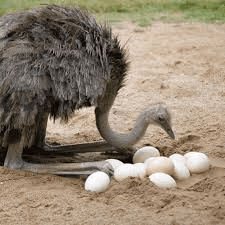The weight of an ostrich egg usually ranges between 1100 and 1950 g, averaging 1600 g. An egg weighing 1522 g is 15.5 cm long, 12.9 cm wide, and measures about 45 cm in circumference.
Compared to a chicken egg with a shape index of 73–78%, an ostrich egg is more oval with an index of 81–85%. The ostrich eggshell is cream colored and glossy. Shell thickness varies from 1.5 to 2.2 mm and is several times that of a chicken egg (0.3–0.4 mm).
Breaking strength is 55 kg/cm2 for ostrich eggs and only 3–4 kg/cm2 for chicken eggs. There are only 16–18 pores/cm2 of ostrich eggshell compared to 70–200 pores in a chicken egg.
The thick shell and the small number of pores enable ostrich eggs to remain fresh for up to 3 months under cold storage conditions. For optimum hatch rate, ostrich hatching eggs should be stored for no longer than 7 days at 12–18°C (53.6–64.4°F) and 70–75% relative humidity.
An ostrich egg weighing 1580 g contains 59.8% albumen, 20.4% yolk, and 19.8% shell. Compared to chicken eggs, ostrich eggs have a higher proportion of albumen and shell with a considerably lower proportion of yolk. Ostrich eggs are known for their high nutritional value.
The egg has a lower proportion of fat than the chicken egg. It is characterized by a higher proportion of SFA (myristic, palmitic, and stearic acids; 39.06% of total fatty acids) and monounsaturated fatty acids (49.06%) as compared to the chicken egg.
The proportion of SFA in ostrich eggs is also higher than in goose, turkey, and especially guinea fowl eggs. The proportion of monounsaturated fatty acids in ostrich eggs is similar to turkey eggs.
The cholesterol concentration of ostrich egg yolk is 17.86 mg/g, which is substantially higher than the chicken egg (13.91 mg/g yolk).
Based on 100 g of liquid edible portion, an ostrich egg contains a higher concentration of vitamins E, B1 (thiamine), B5 (pantothenic acid), and B9 (folic acid), but lower concentrations of vitamins A and B2 (riboflavin) compared to a chicken egg.
It surpasses a chicken egg in terms of calcium, magnesium, manganese, iron, and zinc content (Horbańczuk, 2003).
Unlike the rest of the world, ostrich eggs are often eaten on a daily basis in South Africa. It takes approximately 45 min to soft boil an ostrich egg and twice as long to hard boil it.
The long boiling time is due to the large mass of an ostrich egg, which is around 25 times that of a chicken egg. Ostrich eggs are a valuable and scarce commodity. Worldwide, the sale of ostrich eggs for human consumption is small and consumption of ostrich eggs is considered a luxury.
In Poland, ostrich eggs are bought for special occasions such as birthdays and wedding anniversaries. Some restaurants serve scrambled ostrich eggs to bring a touch of originality and exoticism. Scrambled eggs from 1 ostrich egg will feed 8–10 people. In the past, ostrich eggs were cult objects.
They were offered in temples (Copts) and used as protection against lightning (Ethiopia). Ostrich eggshells were used to carry and store water (Bushmen) and to make vases or cups (Egypt). In many countries of the world, ostrich eggshells have long been used to make painted eggs and decorations.
The common ostrich is the largest living bird in the world. Male ostriches may reach 2.7 m in height, whereas female ostriches may be 2 m tall. South Africa is the global leader in ostrich farming with around a million ostriches kept on almost a thousand farms.
Large ostrich populations are also raised in North America (mainly in the United States and Canada), South America (especially in Brazil and Chile), Europe (mostly in Italy, Spain, and Poland), and Asia (mainly in Israel and China).
Wild ostriches become sexually mature at 4–5 years of age (Reiner, 1995). Farmed females lay their first eggs at the age of 2–2.5 years, and males reach sexual maturity at the age of 3 years. Under natural conditions, a female ostrich lays 12–18 eggs.
Under farm conditions, young females produce 10–20 eggs in the first year and from 40 to 130 eggs annually (most often 40–60 eggs) in subsequent years. Due to optimal conditions (warm and dry climate), the laying performance of ostriches raised in Africa is 30–35% higher than in Europe.
Female ostriches can produce eggs for 40 years or longer. They reach peak egg production between 7 and 11 years of age. In the United States, females lay eggs between January and September for 6 months in the north and for as long as 9–10 months in the south (Hicks, 1992).
In Europe, the laying season usually takes place from March to the end of September, in South Africa from June to late February/early March, and in Israel from January to the end of August.
In Poland, peak of lay is in May and June, when a female lays 40–50% of annual egg production, including 10% in August and 4–5% in September (Horbańczuk, 2003).
Description

Ostrich, (Struthio camelus), large flightless bird found only in open country in Africa. The largest living bird, an adult male may be 2.75 metres (about 9 feet) tall almost half of its height is neck and weigh more than 150 kg (330 pounds); the female is somewhat smaller.
The ostrich’s egg, averaging about 150 mm (6 inches) in length by 125 mm (5 inches) in diameter and about 1.35 kg (3 pounds), is also the world’s largest.
The male is mostly black but has white plumes in the wings and tail; females are mostly brown. The head and most of the neck, reddish to bluish in colour, is lightly downed; the legs, including the powerful thighs, are bare. The head is small, the bill short and rather wide; the big brown eyes have thick black lashes.
Study the courtship practices of these flightless ratites and watch a mother ostrich care for its young Ostriches are seen individually, in pairs, in small flocks, or in large aggregations, depending on the season.
Read Also : Chocolate Point Siamese Cat Breed Description and Care Guide
The ostrich relies on its strong legs uniquely two-toed, with the main toe developed almost as a hoof to escape its enemies, chiefly humans and the larger carnivores. A frightened ostrich can achieve a speed of 72.5 km (45 miles) per hour. If cornered, it can deliver dangerous kicks.
Ostriches live mainly on vegetation but also take some animal food, mainly insects; they can go without water for long periods. Breeding males emit lionlike roars and hisses as they fight for a harem of three to five hens.

A communal nest scraped in the ground contains more than a dozen shiny, whitish eggs. The major hen of the harem may get rid of some of the eggs to make incubation more manageable.
The male sits on the eggs by night; the females take turns during the day. The chicks hatch in about 40 days and when a month old can keep up with running adults.
To escape detection, chicks as well as adults may lie on the ground with neck outstretched, a habit that may have given rise to the mistaken belief that the ostrich buries its head in the sand when danger threatens.
Ostrich plumes adorned the helmets of medieval European knights, and in the 19th century such plumes were sold for women’s finery.
This demand led to the establishment of ostrich farms in South Africa, the southern United States, Australia, and elsewhere, but the trade collapsed after World War I.
Ostriches are now raised for their meat and hide, which provides a soft, fine-grained leather. The birds have been trained for saddle and sulky racing, but they tire easily and are not well suited for training. They do well in captivity and may live 50 years.
The ostrich is typical of a group of flightless birds called ratites. Ostrich populations differing slightly in skin colour, size, and egg features formerly were considered separate species, but now they are considered to be merely races of Struthio camelus. Most familiar is the North African ostrich, S. camelus camelus, ranging, in much-reduced numbers, from Morocco to Sudan.
Ostriches also live in eastern and southern Africa. The Syrian ostrich (S. camelus syriacus) of Syria and Arabia became extinct in 1941. The ostrich is the only living species in the genus Struthio.
Ostriches are the only members of the family Struthionidae in the order Struthioniformes a group that also contains kiwis, emus, cassowaries, and rheas.
The oldest fossil relatives of ostriches belong to the species Calciavis grandei, which were excavated from the Green River Formation in Wyoming and date to the Eocene Epoch, some 56 million to 34 million years ago.
Can you Eat Ostrich Eggs?
Yes, an ostrich egg is edible and you can eat them. One egg contains around 2,000 calories. Compared to a chicken egg, it has more magnesium and iron, but fewer vitamins E and A.
But in reality, cooking or eating an ostrich egg is not very practical. According to the American Ostrich Association, it would take almost 90 minutes to hard boil an ostrich egg.
Frying the egg is also not recommended. It’s unlikely most people would have a large enough skillet or utensil to manage the size of the egg. Also, the shell is so incredibly hard, it takes a hand saw or a hammer to crack it!
Given all that about the eggs, it’s a fair question to ask “can you eat ostrich?” The answer to that is yes and in fact, many people encourage it.
Ostrich meat is one of the healthiest red meats around. It is easily digestible making it a good choice for people with sensitive stomachs. It’s very lean and full of flavor. It tastes like a premium cut of beef and can replace beef in recipes at a one-to-one ratio.
Ostrich is also humane and sustainable. Most ostriches live on farms with open fields. They are not given steroids, hormones, or antibiotics.
In addition, raising ostriches actually reduces the impact on the environment as compared to raising beef. They require less water and land than beef cattle do. They produce less greenhouse gas and give off almost no methane.
Health Benefits of Ostrich Eggs

Ostrich eggs offer many of the same benefits as chicken eggs. This is good, seeing as many health experts consider eggs to be one of the healthiest foods on the planet.
Ostrich eggs contain:
- Lots of protein (176g per egg)
- Vitamin A
- Calcium
- Iron
- Magnesium
- Potassium
Eggs also contain natural bioactive compounds that help promote human health and ward off disease. The yolk especially is home to several different active ingredients like triglycerides and phospholipids that promote digestion and regulate your metabolism.
How much Food is One Ostrich Egg?
To understand just how big an ostrich egg is, let’s compare it to a chicken egg.
A jumbo egg is about 70 grams, while ostrich eggs are about 1400 grams on average. Therefore, roughly 20 chicken eggs equal one ostrich egg.
When you break down the cost of an ostrich egg, it’s still more expensive than traditional eggs. But keep in mind it’s an exotic animal, and things like shipping costs have to be factored in.
Like other eggs, ostrich eggs can spoil. So you’d either need a group of hungry adventurous people to join you or a serious appetite to eat that much in one sitting.
Read Also : British Blue Cat Breed Description and Care Guide
How do you Cook Ostrich Eggs?
You can cook an ostrich egg the same way you’d cook chicken eggs. There are plenty of ostrich recipes out there for you to choose from. You’ll obviously need a larger cooking apparatus, but it’s pretty much the same process.
Boiling an ostrich egg is common for people that have never cooked them before. It takes about 60 minutes to soft-boil and 90 minutes or more to hard-boil, depending on size.
Fried or scrambled ostrich eggs are also common methods. Line your pan with non-stick spray or olive oil, then cook for 20 to 30 minutes. Season with salt and pepper and add cheese if you like. Scrambling is probably the easiest method out there.
You could attempt to make an omelet but you’ll probably need a very large skillet. Even then, you most likely won’t be able to get it thin enough to flip or fold over. Maybe try making a few “smaller” (relatively speaking) omelets instead.
If you like your eggs slightly runny, that’s fine, too. You don’t need to overcook the egg for fear of bacteria or anything else!
Human Uses
In Thebes, Egypt, the tomb of Haremhab, dating to approximately 1420 BC, shows a depiction of a man carrying bowls of ostrich eggs and other large eggs, presumably those of the pelican, as offerings.
Ostrich eggshells were used as containers in North Africa as early as the fourth millennium BC and in the Royal Cemetery at Ur from the third millennium.
From the first millennium in the ancient Punic civilization, there are many examples of ostrich eggs decorated with painted geometric designs for use as cups and bowls.
These have been found in Carthage, Sardinia, Sicily, the Iberian Peninsula and Ibiza. The tradition of using ostrich eggs as containers (sometimes decorated) continues to the present among the San people.
In the Middle Ages, ostrich eggs from Ethiopia were exported through the port of Bāḍiʿ on the Red Sea.
During the Renaissance in Europe (15th–16th centuries AD), ostrich eggs were mounted in silver as goblets for display in cabinets of curiosities. Decorated eggs continue to be widely displayed in Eastern Orthodox churches, although their symbolism is disputed.
They may symbolize the Virgin Birth, since according to Job 39:13–17 the ostrich lays its eggs in the sand and forgets, so they are hatched by the sun alone. This significance may lie behind the egg suspended above the Virgin Mary in Piero della Francesca Brera Madonna painting.
In 2020, studies of decorated ostrich eggs in the British Museum showed that the methods by which they had been sourced, produced and traded were more complicated than had previously been imagined.
Isotope analysis showed that eggs from the same archaeological site had originated in different places. The studies suggested that, rather than the eggs having been laid by captive birds, almost all had most likely been collected in the wild; a potentially hazardous undertaking. Today, ostrich eggs are a special luxury food.
Read Also : Impact of Agricultural Wastes on Human and Environment

